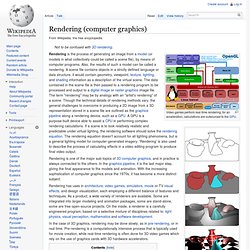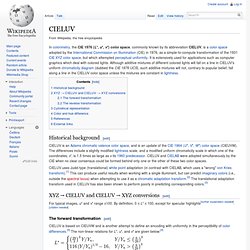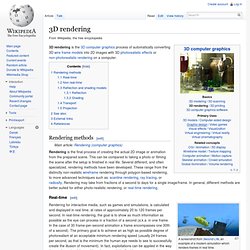

XnView Software - Free graphic and photo viewer, converter, organizer. Scribus.net. Draw Freely. Inkscape at the Libre Graphics Meeting April 12, 2014 The Inkscape project mustered nine developers, translators and document writers for a productive meeting.

As well as countless user interactions over the course of the five day event. This is what happened... Read more... Inkscape sponsoring LGM attendance March 2, 2014 Thanks to generous donations from users, the Inkscape Project is pleased to pay for five developers to attend the Libre Graphics Meeting, to be held in Leipzig in April. The GNU Image Manipulation Program. Ray Tracing - Modeling - Rendering. Rendering (computer graphics) Video games perform real-time rendering; for an acceleration, calculations are outsourced to the GPU.

A variety of rendering techniques applied to a single 3D scene An image created by using POV-Ray 3.6. Rendering is the process of generating an image from a model (or models in what collectively could be called a scene file), by means of computer programs. Also, the results of such a model can be called a rendering. A scene file contains objects in a strictly defined language or data structure; it would contain geometry, viewpoint, texture, lighting, and shading information as a description of the virtual scene. Rendering is one of the major sub-topics of 3D computer graphics, and in practice is always connected to the others. Rendering has uses in architecture, video games, simulators, movie or TV visual effects, and design visualization, each employing a different balance of features and techniques.
Image rendered with computer aided design. CIE 1931 color space. The CIE 1931 color spaces are the first defined quantitative links between physical pure colors (i.e. wavelengths) in the electromagnetic visible spectrum, and physiological perceived colors in human color vision.

The mathematical relationships that define these color spaces are essential tools for color management. They allow one to translate different physical responses to visible radiation in color inks, illuminated displays, and recording devices such as digital cameras into a universal human color vision response. CIE 1931 RGB color space and CIE 1931 XYZ color space were created by the International Commission on Illumination (CIE) in 1931.[1][2] The CIE XYZ color space was derived from a series of experiments done in the late 1920s by William David Wright[3] and John Guild.[4] Their experimental results were combined into the specification of the CIE RGB color space, from which the CIE XYZ color space was derived. CIELUV. Historical background[edit] CIELUV uses Judd-type (translational) white point adaptation (in contrast with CIELAB, which uses a "wrong" von Kries transform).[1] This can produce useful results when working with a single illuminant, but can predict imaginary colors (i.e., outside the spectral locus) when attempting to use it as a chromatic adaptation transform.[2] The translational adaptation transform used in CIELUV has also been shown to perform poorly in predicting corresponding colors.[3] XYZ → CIELUV and CIELUV → XYZ conversions[edit] For typical images, u* and v* range ±100.

By definition, 0 ≤ L* ≤ 100, except for specular highlights[further explanation needed]. [citation needed] The forward transformation[edit] CIELUV is based on CIEUVW and is another attempt to define an encoding with uniformity in the perceptibility of color differences.[4] The non-linear relations for L*, u*, and v* are given below:[4] The reverse transformation[edit] The transformation from (u′, v′) to (x, y) is:[6] 3D rendering. 3D rendering is the 3D computer graphics process of automatically converting 3D wire frame models into 2D images with 3D photorealistic effects or non-photorealistic rendering on a computer.

Rendering methods[edit] Real-time[edit] A screenshot from Second Life, an example of a modern simulation which renders frames in real time. Rendering for interactive media, such as games and simulations, is calculated and displayed in real time, at rates of approximately 20 to 120 frames per second. In real-time rendering, the goal is to show as much information as possible as the eye can process in a fraction of a second (a.k.a. in one frame. Non real-time[edit] An example of a ray-traced image that typically takes seconds or minutes to render. Computer-generated image created by Gilles Tran. Animations for non-interactive media, such as feature films and video, are rendered much more slowly.